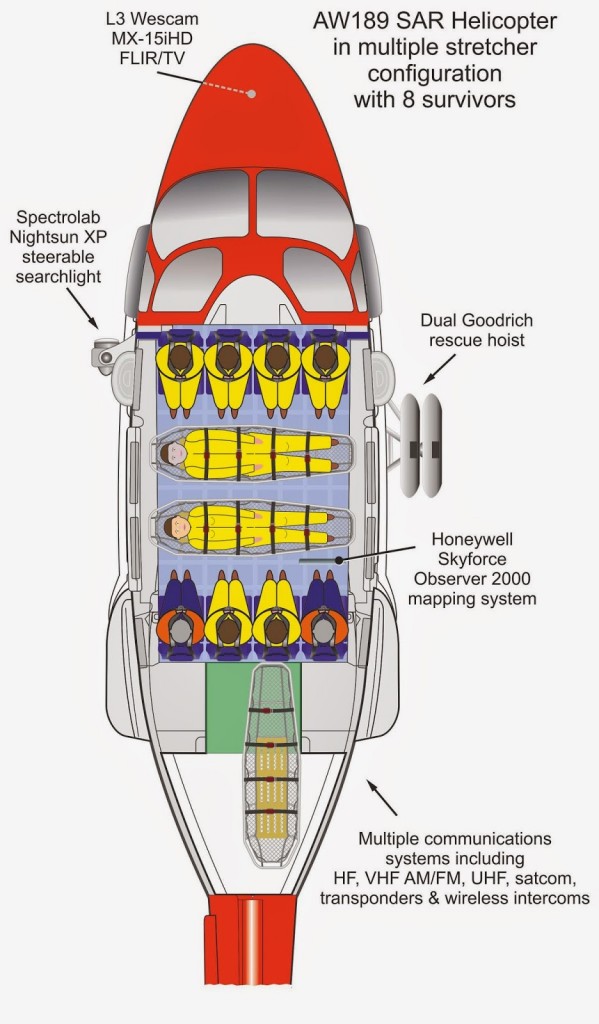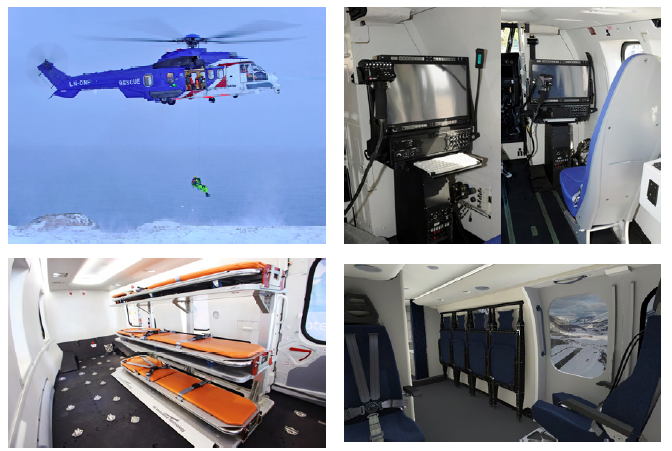Increasing SAR Use by the Oil & Gas Industry
The oil and gas industry is increasingly contracting commercial Search & Rescue (SAR) helicopters to support offshore exploration work and support offshore safety cases.
For example, commercial operator Bristow has provided a SAR service in the UK since 1971 (for both government and oil and gas customers) that has flown more than 44,000 SAR operational hours and over 15,000 SAR missions. They currently also deliver oil and gas SAR operations in Australia, Brazil, Canada (via Cougar – video), Norway (video), Russia, Tanzania and Trinidad.
Bond Offshore Helicopters (part of Avincis) operates the so called JIGSAW service for BP in the North Sea (video).
CHC meanwhile provide SAR in a number of locations including UK, Ireland and Norway (video 1, and UPDATE Sept 2014 video 2). Meanwhile NHV (video) now provide SAR cover to the Dutch oil and gas association (NOGEPA). There are of course other operators…
One of the latest operations to start up is Shell‘s contract with CHC in Broome, Australia with an Airbus Helicopters EC225, announced today.
This service is on standby 24-hours a day and is able to respond within 15 minutes during daylight hours and 30 minutes at night. Initially the service will be daytime SAR, with a medevac capability only at night. Medical Rescue Air Ambulance is providing the paramedic SAR crew for the service. As has become common in these circumstances, when the capability is not required for oil and gas activities, it may be tasked by the local authorities to assist with other medevac and SAR needs.
CHC Asia Pacific’s Regional Director Nick Mair explained:
Early next year, a new, state-of –the- art, all-weather SAR helicopter will enable full, 24-hour search and rescue coverage.
This, and the earlier videos, neatly highlight the distinction between a LIMSAR (Limited SAR) capability that is daylight (and fair weather only) and a full AWSAR (All Weather SAR) capability that can also operate at night. Even LIMSAR, is a step beyond simply using a winch equipped helicopter in an emergency.
Key aircraft upgrades essential for AWSAR is the addition of a 4-axis autopilot with auto-hover (and ideally a means for the winch operator to ‘trim’ the aircraft position) and a means to aid search such as FLIR (Forward Looking Infa Red) turret with a suitable operator interface and a Night Vision Imaging System (see a recent example certified here). Clearly even for LIMSAR, the helicopter needs to be winch (or ‘hoist’) equipped. For a permanent standby capability of the AWSAR a dual winch is essential to give redundancy. However, to provide a SAR service you need an offshore equipped helicopter with those features and:
- Extensive SAR, winching & medical equipment
- A carefully planned SAR cabin fit, with a sea tray (to protect the floor from sea water and bodily fluids), equipment stowage etc
- External winch lighting (including a Nitesun type search light)
- Direction finders (and ideally the ability to decode the <50 millisecond periodic burst transmissions from 406MHz beacons)
- Extra radios including satellite communications when operating at long ranges including, SAR crew intercoms / radios etc
- Automatic Identification System (AIS) to detect shipping (important when hovering in low visibility at low altitude – a Royal Navy Westland Lynx helicopter was knocked into the sea by an Omani ship in 2001!)
- Suitable stand-by accommodation and an ops room close to the aircraft with full communications
- Engineering support scaled to minimise aircraft downtime
- Detailed and documented SAR procedures that are both approved by the local regulator (including any dispensations necessary) and effective(!)
Most those features are also necessary for LIMSAR.
And last but by no means least, sufficient trained crew (both front and read crew working effectively together). SAR is more complex than simply normal winching (e.g. personnel transfer). Not only does it demand high experience levels but it also demand constant training to stay current in all likely operational scenarios and ensure effective crew performance is maintained. For example Bristow has recently been conducting start-up training for another SAR operation in Australia.
The importance of training and procedures are highlighted by this Australian Transport Safety Bureau (ATSB) report into a 2011 winching accident involving a Helicopter Emergency Medical Service (HEMS) operator that did some incident SAR work. ATSB have another investigation on-going from 2013. The Spanish accident investigation agency (CIAIAC) published this report on the loss of a Spanish SAR helicopter in 2010 which has similar lessons. Aerossurance has previously commented on a tragic and unnecessary US onshore SAR accident, that emphasised the importance of procedures, good judgement and management control.
Examples of AWSAR fit can be seen with the Bristow Redhill Design Office designed configurations of the Sikorsky S-92A and AgustaWestland AW189 (a type previously discussed by Aerossurance here) being introduced by Bristow for the HM Coastguard contract recently discussed at the Royal Aeronautical Society.
Another example are these photos of an Airbus Helicopters EC225:
Also see these brochures:
Contracting a SAR Service
The International Association of Oil and Gas Producers (IOGP) does have some basic guidelines for SAR. However, they barely cover the detail to be specified to contract for the most demanding AWSAR contracts.
The very first step is to understand the desired rescue capability (in terms of locations, quantity of personnel, environmental conditions, stand-by times and survival / rescue times.
The more reputable and competent helicopter operators do understand the range of equipment, facility, procedural, personnel and training requirements for SAR, but it is still vital to agree explicit contractual requirements.
Aerossurance has however sadly encountered operators that have not appreciated the true capability required and:
- Failed to have current SAR procedures
- Offered aircraft without adequate performance
- Offered aircraft that did not have basic equipment for offshore operation (let alone SAR)
- Offered aircraft without the autopilot capability for the proposed mission
- Offered crews that were not SAR current
- Misrepresented LIMSAR as AWSAR
In other cases Aerossurance has found that customers specified individual requirements without specialist aviation support. Rather than create a holistic specification for a SAR service (their intent) they produced a disjoined specification where the sum of the limited parts did not produce a SAR service capability (though the helicopter operator was technically compliant with the specification).
UPDATE 24 March 2015: Video report on the CHC H225 at Broome:
https://www.youtube.com/watch?feature=player_detailpage&v=JALrK_GpAHg
UPDATE 30 March 2015: Oil and Gas UK announce that oil and gas companies in the Central North Sea have committed to a 5 year, £60 million contract with Bond for a prime and standby SAR helicopter to cover that area (not stated but almost certainly AS332L2s used previously for JIGSAW).
UPDATE 3 November 2015: Bond North Sea SAR training footage
UPDATE 7 October 2016: Currently both the EC225 and AS332L2 are unavailable for SAR in Norway and the UK. Read more here: EC225 LN-OJF Accident Investigation Timeline
UPDATE 19 December 2016: The Tender Trap: SAR and Medevac Contract Design
UPDATE 21 March 2017: Bristow forms new SAR consortium for Gulf of Mexico
UPDATE 11 May 2020: European Search and Rescue (SAR) Competition Bonanza
SAR Consultancy: Procurement, Tenders, Contacts and In-Service Assurance and Aviation Advice
In September 2017 one European Coast Guard selected Aerossurance to be their new aviation consultants after a competitive tender with 7 bidders. In July 2018 Aerossurance started work supporting a second European Coast Guard with a procurement project. The Aerossurance team is and has supported humanitarian aid agencies, air ambulance charities, military air arms, environmental agencies and blue chip energy companies on other emergency service and special mission aviation projects around the world.
The Tender Trap: SAR and Medevac Contract Design: Aerossurance’s Andy Evans discusses how to set up clear and robust contracts for effective contracted SAR and HEMS operations.







Recent Comments